Leg #1, San Francisco to Tahiti
Daily updates from a first-time captain sailing across the Pacific
See leg two (Tahiti to Hawaii) and three (Hawaii to San Francisco single-handed)
Contact details + departure
Mar 13, 2024
Hello Friends,
After over a year of planning, we are departing this Friday for French Polynesia! The boat feels ready and we're excited. Today we loaded a small mountain of food onto the boat (e.g. 35 pounds of granola). The weather forecast is clear.
I'll post updates to this group via satellite phone as we go (probably daily, although don't get scared if I miss one). I won't be able to access my regular email or phone. However, I will get emails to: XXXXX or SMS messages to XXXXXXXX.
I'll miss you all, and look forward to seeing you again in July!
Take care,
Ammon
Departure
Mar 15, 2024
And, we’re off! We sailed out of the bay this morning with an ebb tide, 17 knots of wind, and bright sun. Friends were on the golden gate bridge as we sailed under. It was special.
Right now, we’re 5 nautical miles south west of Southeast Farallon (29 miles outside of the gate).
The wind dropped off this afternoon. We’re trying to make it far enough west to avoid light wind tomorrow and Sunday. Fingers crossed.
Land is still in sight. I expect to lose sight of the coast in a few hours and the Farallons by tomorrow. From then on, it’ll just be water.
-Ammon

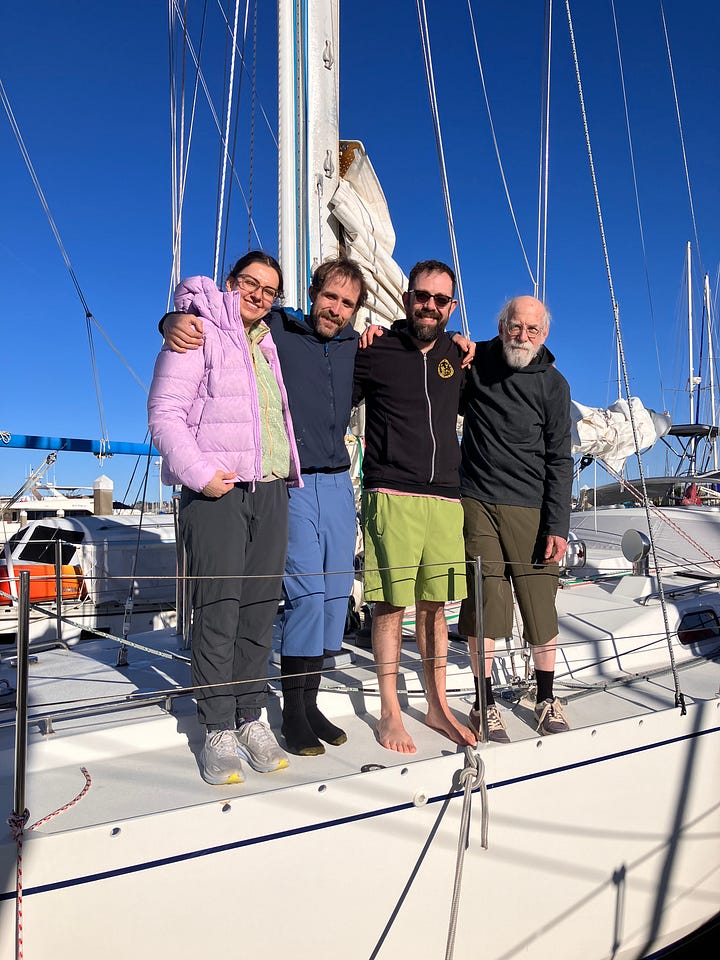
Day 2
Mar 16, 2024
36°26’N 124°59’W. Sun run sun celestial fix as of 1500 today. Chart shows 16,000 feet of water under us.
Last night, we had a steady 10 knot wind, close to directly behind. We ghosted along beautifully all night at ~ 4 knots. You could clearly see the stars reflected in the water. There was bioluminescence in the boat’s wake too. Really beautiful.
We made 120 nautical miles noon to noon. Not bad. However, as expected, the wind has dropped further today. Kai started the engine on his watch because we’d lost steerage without it, and we’ve been under power all day. The forecast shows better winds early next week. So until then it might be a bunch of motoring (I want to get south, out of any risk from North Pacific winter storms, so we’re not going to wait for wind).
I took our first celestial running fix this afternoon. I’d not done the calculations in a long time and had to think a bunch to get everything right.
Everyone is enjoying the experience. Nurcan just told me she feels happy! So far, this has been a mild introduction to open ocean sailing.
-Ammon
Spinnaker!
Mar 17, 2024
34°53’N 126°26’ W. Celestial fix at 0900.
We spent all today under spinnaker! 122 nm noon to noon run. Another beautiful, clear day. There were no complaints about the light wind. Everything was too beautiful. We’re back to wing on wing with the jib on a pole for night (don’t want to fly the spinnaker in the dark). No bites yet on our fishing line.
Tomorrow is forecast to be light air as well. By Tuesday, I hope to reach better wind and turn directly south. I need to get a few minutes of rest before my watch.
-Ammon
Day 4
Mar 18, 2024
33°35’N 127°20’W. Celestial fix.
Another day under spinnaker! We’re making 7.5 knots now. However, we were making 2 to 4 all last night, so only a 90 mile run today. We’ve been routing west of the rhumb line on the advice of weather routing software (to try to avoid a high pressure cell with low wind). However, in hindsight, I think this was a mistake. We’ve ended up right in the middle of the pacific high. So it’ll be at least a few more mild days before we reach stronger winds. We’re heading due south now.
-Ammon
Getting into a routine
Mar 19, 2024
32°12’N 128°16’W, as of 1444 today (celstial fix).
Air and sea are noticeably warmer. We’re making progress south! We had good wind all day today — reached with the spinnaker, and just switched to the main / genoa for the night (we don’t fly the spinnaker on single-handed night watch). This will be our highest single day run. Right now we’re healed over 15 degrees and making 6.5 knots, which of course is really a moderate bicycle speed. But right now, on this boat, it feels like we’re zooming over a foreboding ocean. We’ve had smooth conditions for the last 5 days. I expect the next 5 to be faster but rougher.
My father started standing watch last night. Having 4 people makes a big difference. I’m not sure if he can keep doing it in rough conditions, but if he can, we all get a solid night of sleep.
We had a bit of a scare with the forward bilge today. I noticed yesterday that there was water in the forward bilge. I turned off the automatic bilge pump so I could measure the paccumulation rate. Well, today the high water alarm went off. There was about 1.5 gallons of water (accumulated over 20 hours). The good news is that it was fresh water (indicating a plumbing problem) rather than salt water (which would indicate a leak). I’m 85% sure the problem is a leak from our gray water tank (thankfully this is different from our black water tank). I’m running a test to confirm. We have a desalinator and 3 reserve tanks of water. So we’ll be fine in any case.
-Ammon
Untitled
Mar 20, 2024
30°50’N 129°55’W, as of 1530 today (celstial fix)
I was late to work my celestial fix today, so I just finished it. Need to get some sleep before my watch at midnight. However, quick updates:
The water leak was not from the gray water tank (meaning it is loss from our potable water stores). I ran the desalinator for the first time today and refilled all tanks. I’ll be doing more work to track down where the leak is.
We’ve covered 600 miles!
All weather models show stronger winds arriving tomorrow (and taking us all the way to the trades). We’re looking forward to it.
No bites yet on our fishing lines.
-Ammon
One weak at sea!
Mar 21, 2024
29°33’N 131°17’W as of 1649 today (celstial fix)
Well, stronger winds and larger waves have arrived. We spent today beating into 15 knots increasing to 20 by end of day, waves 5 feet and growing. Everyone took seasickness meds, which worked, but meant that crew not on watch were mostly knocked out in their berths. Not a social day.
We expect the wind to shift to the north tonight, and to finally have downwind conditions to the trade winds. The winds will stay high, but a downwind point of sail should be considerably more comfortable.
The bad news is that Kai hit his head with some force today. He did not lose consciousness. We’ve taken him of off night watch for tonight and will be looking for concussion symptoms. I’ll contact a doctor if he has any symptoms.
Good news is that our leak seems to no longer be leaking. I believe it was the gray water tank after all. I’d ruled that out because some water accumulated after I dumped the tank. However, there’s been no new water for the past 2 days. I think the little bit of accumulation may have just been water caught behind hull stringers spilling as the hull tilted.
-Ammon
Update: looks like this failed to send last night. Kai’s up and OK. We’re in 7-foot seas running before 20 knots, making between 6 and 9 knots directly toward the marquesas. I’m glad we have a jibe preventer.
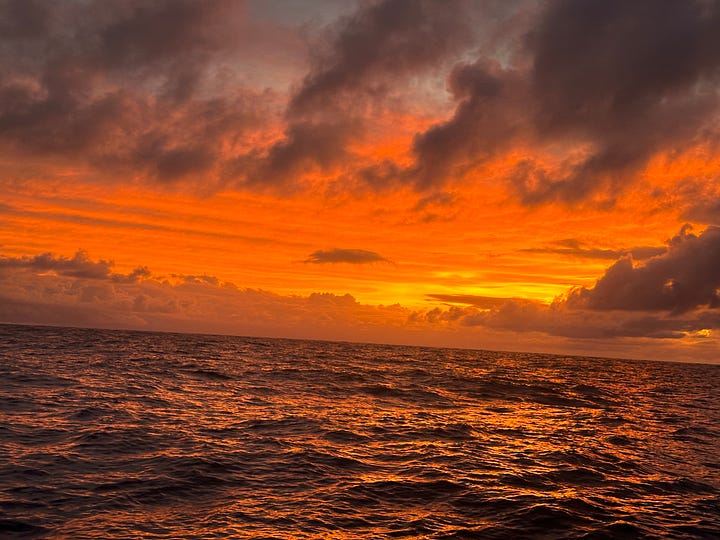
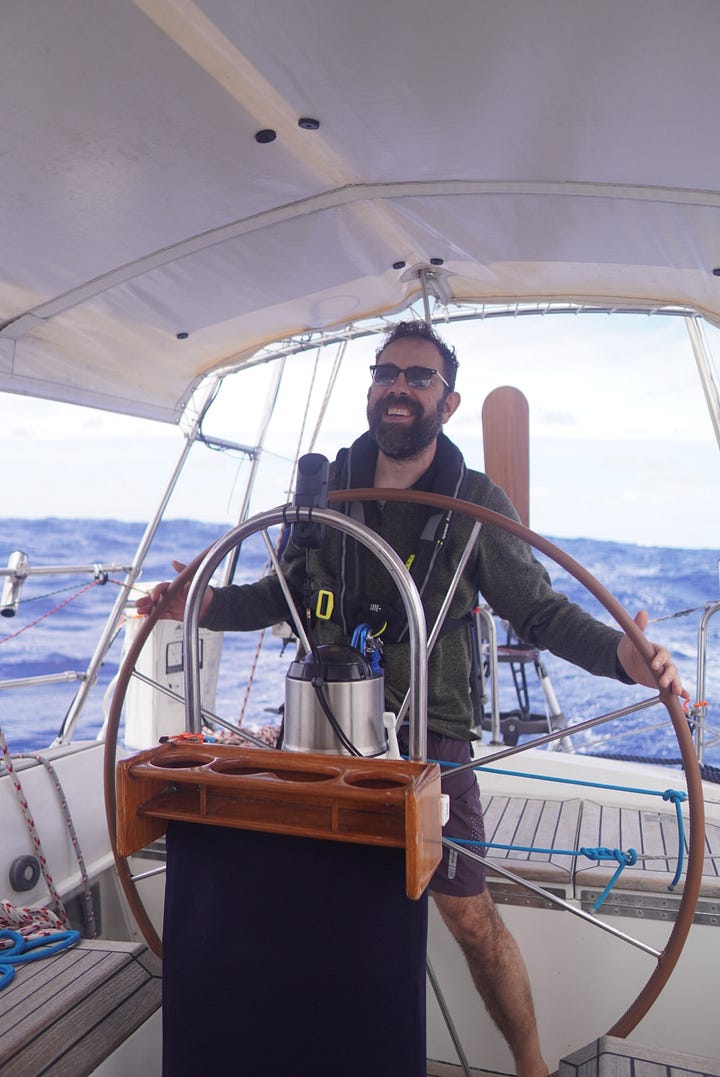
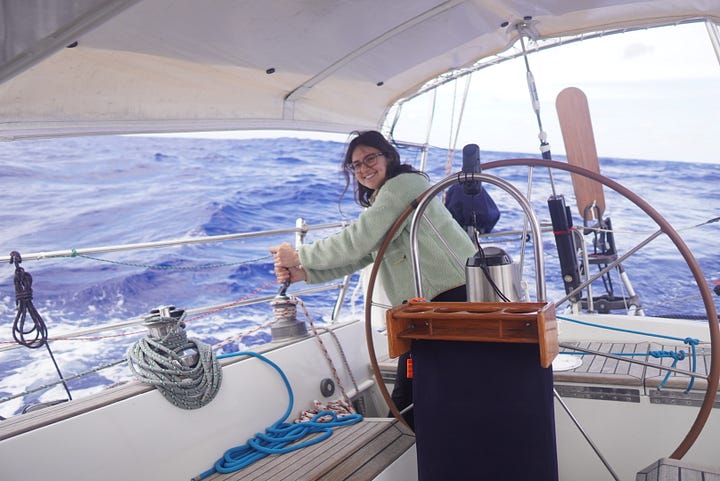
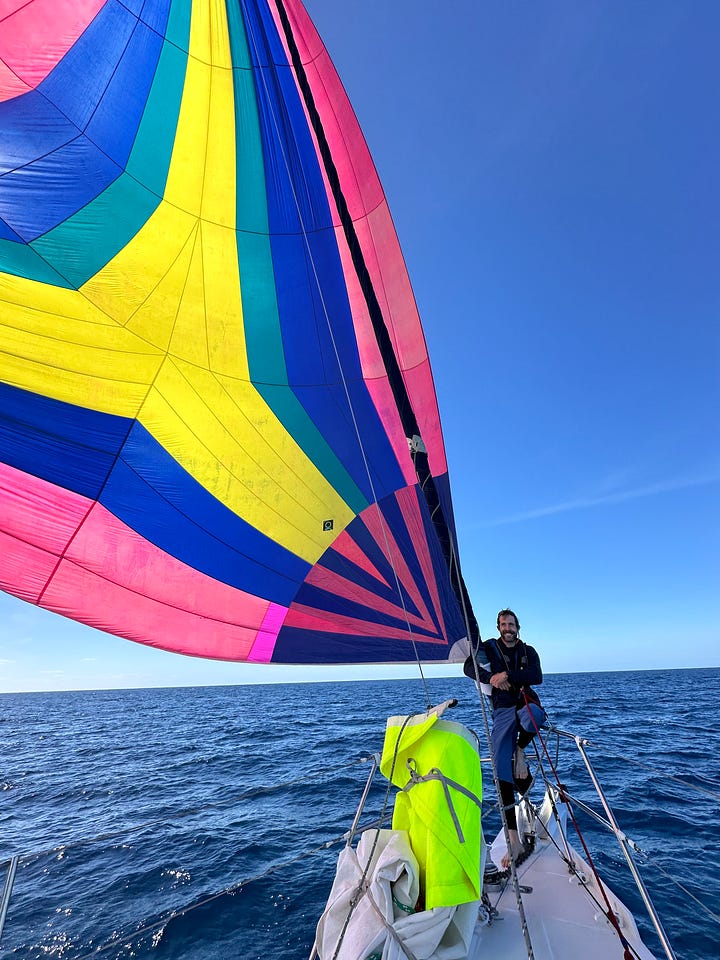
Running…
Mar 22, 2024
Approximately 27°15’N 132°11’W
I didn’t work a fix today — too cloudy in the morning and too much else to do in the afternoon. I put a DR (dead reckoned or estimated position) on our passage chart.
Kai is feeling mostly better, which is a relief, also, confirmed for the 3rd day in a row, we are not leaking water.
We’ve been flying all day. We tacked south at 0300 this morning, and ever since we’ve been running wing on wing (with a the genoa on a pole). We’ve been over 6 knots all day (the max I saw was 10.4, surfing down a wave). This will be our largest 24-hour run to date for sure.
However, it’s not comfortable. Waves are large and building, and the rolling motion inside the boat is hard from some of the crew to deal with. I’m worried that no one other than me enjoyed today. We have strong winds forecast for the next 5 days, so tomorrow I’m going to try to get into a broad reach rather than a run, and see if that helps.
Today I fixed our windvane, which involved drilling a new (fairly precise) mounting hole through the shaft. It was hilarious to try to do this in the rocking and pitching boat.
I made a ginger molasses cake with dinner today to celebrate one week at sea.
-Ammon
Untitled
Mar 23, 2024
25°19’N 132°55’W via GPS
I again did not complete a celestial fix, due to clouds in the late afternoon. I went ahead and logged a GPS position for safety.
Today the large waves continued (approx 8 feet) When you’re in the cockpit, it inspires awe - the waves rolling in from behind, towering over your line of sight, then the boat, impossibly, raising, raising, and accelerating as it surfs down the face. Inside the boat, however, the experience is more like unpredictable lurch forward, followed by a hard tilt to port of starboard by as much as 30 degrees, then a loud grown from the mast and rush of water. The fact that the boat on a run in large waves can lurch in either direction makes it hard to brace yourself. As you may imagine, we all spent most of the day in the cockpit.
I fixed the steering windvane today (reattaching the part that I was working on yesterday), which involved hanging off the back of the boat. We’ll use a lot less power tonight with the electronic autopilot off.
I also inspected (and lubricated) the steering quadrant and cables. We hove to to do this. It was wild in the waves.
I’m pulling a new weather report now, but we hope to be off this run and onto a reach sometime tomorrow. We’ll all appreciate the change.
We passed the 1000 mile mark today. One third of the way there!
-Ammon
Solo night watch
Mar 24, 2024, 0200
Sailing alone at night is one of my favorite things about being out on the boat. Right now, Nurcan, Kai and my father are sleeping. I’m alone in the cockpit, with a cup of tea and a red headlamp (to keep my night vision). I just tweaked the genoa trim, and we’re rocketing along (7.5 knots). I can see each wave behind us as it approaches (at head level). The motion is intoxicating. The boat leaps forward and is caught softly on a roar of white water. I have the moon and the full sky of stars and clouds open over me. We’re not seen another ship in days. I feel profoundly remote.
-Ammon
Self stearing (Old Daniel)
Mar 24, 2024
22°31’N 133°25’W DR
Again, I failed to get a celestial fix (3 days in a row). I almost got the 2nd sight I needed through a hole in the clouds. Tomorrow, I’m going to make it a priority.
Last night, we all slept poorly, because of the waves and constant rocking of the boat. It was actually worst when the wind decreased—then the stability of the wind on the sail dropped away and we were a cork on wild waves. Twice I woke in the night to the roar of flapping sails and crashing pots, thinking we were facing a surprise gale. When I threw on my harness and went to the cockpit, the wind was 10 knots. Ten knots of wind with 8 to 10 foot waves is worse than 20 knots of wind, it ends up.
Everything got better in the morning. We jibed to a higher course (which increases boat stability), and the waves stretched out. I made cheese omelette with toast for everyone. A pair of black footed albatross circled the boat for 20 minutes. We took saltwater bucket showers in the cockpit. We had the first bite on our fishing line (which unfortunately broke the line and took the lure). Still, this is proof that fish are out there.
Tonight is wild again. The wind is stronger and the waves larger than last night. I’m steering a higher course and trying to keep the sail powered up (to minimize rocking). I hope everyone is sleeping.
All through these high waves, our wind vane has been doing an excellent job steering. We’ve named it “Old Daniel” after Daniel de Hass (who spent a sunday cleaning its bearings with me). It’s a beautiful, purely mechanical device, where the force of the wind pushes a small vane, the slight force from this vane rotates a small paddle in the water. Water pushes the paddle with high force, and lines from the paddle tie to the ships wheel, and physically turn it left or right. The system has to be tuned and tweaked (sails have to be balanced). But once Old Daniel is set, he’s yet to fail us.
-Ammon
Fish vs albatross
Mar 25, 2024
20°48’N 133°32’W as of 1600. I finally got a celestial fix.
We’re flying. 172 miles run in the last 24 hours. Two reefs in the main. 25 knots sustained wind, waves 8 to 10 feet. Today Kai said “somehow going 9 knots in a sailboat feels faster than going 100 mph in a car.”
Everything is going well. We’ve solved the comfort issue (everyone can sleep on this course). My father just stood solo night watch with gusts to 30 knots, and was confident and in control.
Yesterday we hooked a 2nd fish. We have an indicator rigged to let us know when a fish pulls on a line. However, I did not notice until two albatross started diving repeatedly at our line. I was worried they were going to hook themselves and went to bring the line in, to discover a beautiful bull dorado, maybe 25 inches long. He shook free of the hook, however, as I was trying to get him onto the boat. Still, two fish hooked in 2 days. I think we’ll catch one soon.
My favorite part of each day is dinner. We eat out of bowls in the cockpit and watch the sun set. Last night we listened to music. I have not spent this much uninterrupted time with my family since I was a kid. The trip’s worth it just for that.
-Ammon
Fish on!
Mar 26, 2024
18°N 134W DR position (no fix) as of 1900
We caught a fish yesterday! Another 5 lb dorado went for our lure, and this time we landed the fish. We were all in the cockpit when the fish struck, and got to see the beautiful green fish arc out of the water. Processing the fish was an operation—trying to follow downloaded YouTube instructions while the boat heeled at 25 degrees and went over 8 foot waves. But we made it work and prepare the freshest ceviche I’ll ever have.
The waves continued to build after we caught the fish. By midnight, we had confused 10 foot wind waves. We were taking waves into the cockpit. This is still no threat to the boat, but it is trying for us. A sailboat in a storm is cacophonous—high pitched buzz of wind in the rigging, groaning of the hull and shrouds under load, the rush of water as the boat surges, a smash smash each time the hull hits a new wave. This is to say nothing of the motion or of being hit by stinging, dark water in the cockpit while on solo watch. We slept little last night. I’m holding down the boat right now, while everyone else tries to get some rest.
In the middle of the crazy waves last night, a flying fish landed in our cockpit. I threw it back. I guess it was a two fish day!
-Ammon

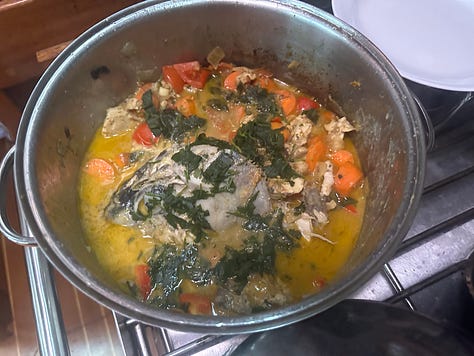
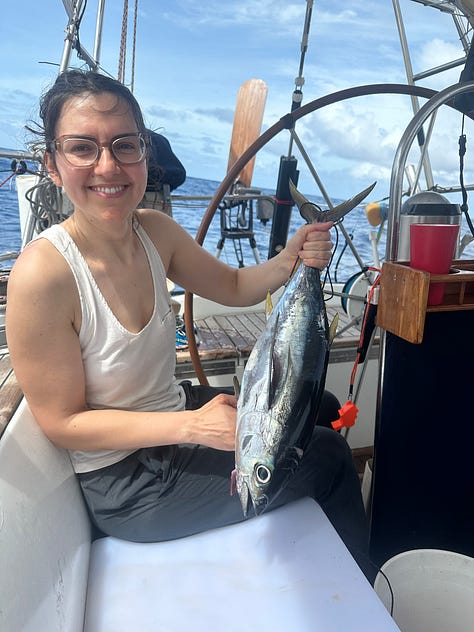
Floools of flying fish
Mar 27, 2024
13°6’N 135°6’W as of 1850
Today was mild and sunny (the first full day of sun in almost a week). We were still double reefed from 25 knot winds the night before, and we chose to keep the reef in and have a super mild day. The batteries were fully charged by 1400, meaning we had excess power and could run the desalinator. Everyone washed clothing and showered in fresh water. Nurcan made a 3 course meal.
Flying fish activity spiked today. For the last few days we’ve seen an occasional flying fish. Today, we saw schools (flocks? floools?) of 500+ flying fish all take off at the same time. The water was covered by silvery dragonflies of the sea.
We are having a worrying engine problem. I inspect and start the engine every few days. The last 2 times, it’s failed to start from the engine battery, and I’ve had to wire the house bank to the engine to get it to start. There is a device that is supposed to connect the two banks when charging, but separate them under load. I think this device has failed, and that we’ve been discharging out engine bank. However, I tried charging it and manually isolating it for 24 hours, and it still failed to start the engine. So now I am concerned that the engine bank may have failed. The other case I have not ruled out is some fault in the starter drawing inordinate power when starting (enough that only the house bank has the juice). I’ll keep investigating. 90% of boat ownership is debugging and repairing.
We’re in tropics! It’s 3am, I’m outside in the cockpit, and, for the first time, there is not even a hint of cold. The sea is warm.
-Ammon
ITCZ and the eclipse
Mar 28, 2024
5°29’N 134°32’W as of celstial fix at 1600
Wind and waves have abated slightly, although wind is still over 20 knots and we’re still double reefed. A more significant decrease is forecast for tomorrow. From tomorrow on, we should have normal trade wind conditions. It will be nice to get the spinnaker up again.
The next obstacle we face is the ITCZ (or doldrums). This is an area around the equator where the northern and southern hemisphere trade winds stop, leaving low, variable wind. We expect to be to the ITCZ in 5 to 7 days. The long-term forecast (as of today) looks favorable (nothing under 8 knots). But we’ll see.
We had gas leak from our dinghy gas can lashed on the side deck today. We took a large wave over the bow and along the side deck, and then we all smelled gas. My hope is that pressure from the wave on the can just forced gas out an over pressure valve. I don’t like gas leaking on the boat (the can is stored on deck, rather than in the hull, to reduce this risk).
The moon is waning, now. We’re trying to reach the path of totality in the South Pacific before the eclipse on March 8th (the new moon, like all solar eclipses). The path of the eclipse is east-west, and about 500 miles north of the Marquesas. My concern now is getting there too early, and having to decide to miss the total eclipse or wait around.
-Ammon
Celestial navigation, heat
Mar 29, 2024
10°4’N 135°6’W as of 1938
It’s hot! We have small fans running on every berth, that just about make it tolerable to sleep. Nurcan loves the heat! She spent all afternoon inside with the fans running reading. She said it was the perfect temperature. She looked happy. For me, the perfect temperature is outside, after the sun sets. I took a bucket bath on deck right before bed. Just a wonderful thing to do. I’m planning to do this every evening.
Winds have stayed strong (15 to 18 knots, seas 4 to 6 feet). We were expecting more of a decrease. Still, these are excellent conditions. A decrease may come over the next few days. Our forecast for the ITCZ is still looking excellent (not very doldrumy). We’re trending a little east over the last 24 hours, but in expect to make this back as we enter the southern trades. I’m worried we’re going to reach the eclipse line of totality much too early and have to decide whether to wait for it.
I take a celestial fix every day. I’ve been doing “sun-run-sun” fixes. You take a sun sight in the morning. This gives you a “line of position” (LOP) on the chart (a line, where your true position is somewhere on that line). If you repeat this process in the afternoon (and also project the morning line forward by your course and estimated distance run), you get two crossing lines. The point where the lines cross is your fix. The trouble is, this process only works if you get crossing lines. As we approach the equator, the sun moves more and more directly overhead. This means it’s never very far north of south of us, and we get increasingly north-south running LOPs from sun-run-sun sights. My two LOPs today only crossed at a 15 degree angle. I need to add in star or moon sights to keep getting accurate results.
I’ve reached out to a diesel mechanic about our engine problem. I hope to get debugging steps tomorrow.
My father is identifying southern stars. We hope to see the southern cross soon.
-Ammon
When sharks attack
Mar 30, 2024
7°20’N 134°30’W as of 2100. DR position. I failed to get a moon or star sight to augment sun sights yesterday. I’m on early morning watch now and the sun has not yet come up. I’ll try to get a moon sight as soon as the horizon is visible.
I heard back from a diesel mechanic. He thinks our engine start battery has simply failed. This is probably the best case (given the symptoms we are observing). I’ve severed the wiring between the engine battery and house battery. We’ll try to replace it at the next opportunity.
The big thing that happened yesterday was the shark attack! I was in the galley. First, Kai yelled that we had a fish on the line. We run two fishing lines at once, and last time we had a fish, tangle was a problem. So this time, Kai starred by bringing in the unused line… only to discover that it had a fish too! We’d hooked two yellow fin tuna. That was when the shark showed up. It put a large gash in one of them. So we prioritized getting that one in. We managed to (one ~8 lb tuna). Before we could get to the 2nd, it had escaped the hook, however.
We had tuna steak for dinner.
2 days ago, we passed out farthest point from land on the trip (no land for 1300 miles in any direction).
Happy Easter!
-Ammon
Equatorial rain
Mar 31, 2024
6°53’N 134°42’Q as of 0900. I got a sun and moon sight this morning, and was able to get a good fix. Of course, we’re probably another 100 miles south by now. The moon sight was interesting. You have to correct for parallax because it’s so much closer than the sun / stars.
Weather on the equatorial ocean is different than on land. First, there are squalls. They are tiny storms (convection cells) with rain, wind, and thunder. However, they are too small (often less than one mile across) to develop revolving winds. The day is sunny and hot, then all within 30 minutes, you see a cloud approach, experience rain and wind (sometimes quite dramatically) and then are back to hot and sunny. Second, water vapor is everywhere. It condenses on every surface. There’s a haze in every direction. It’s rather oppressive. When squalls arrived today, we took off our shirts and basked in the rain.
The wind was shifty today. 8 knots, then 23 knots, north then due west. We’re not going to match our recent daily runs.
There seems to be more and more life in the ocean. Every day, now, we find dead squid and flying fish on the deck. How the squid are getting in to the deck is a mystery to us. At one point today, we saw 20 birds at the sane time. Bio luminescence is back.
Today our iPad stopped charging. I’ve tried everything I can think of. I think we’re going to lose access to it. We can work around this (I loaded all the navigation and communication apps on to my phone as well as backup)
We had excellent tuna curry for dinner. Tomorrow we’re going to put the fishing lines back out.
-Ammon
Surprise gale + Christmas lights of the sea
Apr 1, 2024
3°25’N 135°32’W as of 2100
I got a twilight sight on Sirius and Jupiter after heavy clouds all day. We had a surprise (not forecast) near gale today. Winds 30 sustained, waves 10 feet (with some 12 or 13). We went to a dead run under wind vane. Nurcan, Kai and Stuart handled it (on their watches) with confidence. Mostly, everyone stayed in the cockpit and chortled at every larger and larger wave overtaking us. Kai had to deal with this in the dark. He commented that the bio luminescence in the breaking wave tops lit up each wave as it approached. Mostly, bio luminescence is tiny dots (stars) that glow in the water. However, jelly fish and squid light up like Christmas lights in the sea as our boat passes over them.
We’re down to our last piece of fresh fruit. iPad is still not working.
-Ammon
Approaching the equator
Apr 2, 2024
0°35’N 136°42’W
Thirty five miles to the equator. I’m going to heave to (stop the boat) for a few hours, so we cross in the morning with everyone on deck. There’s a tradition of performing a ceremony as the boat crosses—sacrificing food / alcohol to Neptune and “shellbacks” (sailors who have crossed before) hazing “polliwogs” (those who have not). Trouble is, we’re all polliwogs on this boat. So we’ll need to engage in some mutual hazing. I think Kai has some ideas.
We’ve sailed through at least 4 squalls in the past 24 hours (probably more, while I was asleep). Bright, burning sun, somehow paired with oppressive, hazy, heat. Then a burst of wind. We scramble to reduce sail. 15 minutes of rain. Back to the sun.
I tightened our shrouds today. This is something that I’d rather not do underway. But I replaced compression fittings a few weeks before departing, and a rigger warned me that they would stretch. Yesterday, I noticed that the lee shrouds were slack when the main powered up. You really don’t want this (it creates dynamic loading when the mast can move side to side).
Our refrigeration systems (refrigerator and freezer) are drawing a lot of power. The system is water cooled, but the sea water now feels like bath water. A compressor cycle that would take 5 minutes in SF now takes 15 (and draws 3x the power). Our solar generation capacity has, of course, also increased in the tropics, but the batteries need to be able to store the power. So far we’re OK.
Right now it’s 3:30 AM. Most of the sky is clear. I see an ocean of stars. I still feel heat and moisture in the air. Polaris should be visible, just on the horizon to our stern—a goodbye to the northern hemisphere—but I can’t make it out. There’s another squall dead ahead. Every 30 seconds, I see a flash of lightning.
-Ammon
Shellbacks all
Apr 3, 2024
1°2’S 136°57’W as of 2100
As the “S” above indicates, we’re in the southern hemisphere! We all woke for the equator crossing. I’ve been using my celestial fixes for primary navigation, but for the equator crossing, we watched the GPS screen tick down through 0. We drank a bottle of French Champaign at 9:00 AM. I made chocolate almond cake.
Last night, the sky was almost entirely clear. My father is an astronomy geek, but had never been to the southern hemisphere. At the beginning of my night watch, we identified the southern cross for the first time. I feel like I keep harping on about bioluminescence, but it’s just such so incredibly beautiful. With 0 light pollution, every inch of the sky is studded with points of light. With bioluminescence, the plane of the ocean, every swirl, wave or disturbance shows the same. Two planes of light. We zoom along between.
Kai’s phone has stopped charging now, too, with almost the same symptoms as the iPad. Suspiciously, it’s also a USB-c cord. We now suspect saltwater damage. Our brother Eli introduced us to someone who works in device power at Apple, so we’re getting the highest level of tech support. For now, however, we’re left with only one device set up for satellite communication and charting. I do have an emergency backup for communications and paper charts, so we’ll be ok in any case. l’ll have someone send a notification here if we lose easy contact.
We’re not going to wait for the solar eclipse. The crew wants to head for the marquesas directly. We’re making good time and expect to make landfall in 3 to 4 days.
-Ammon
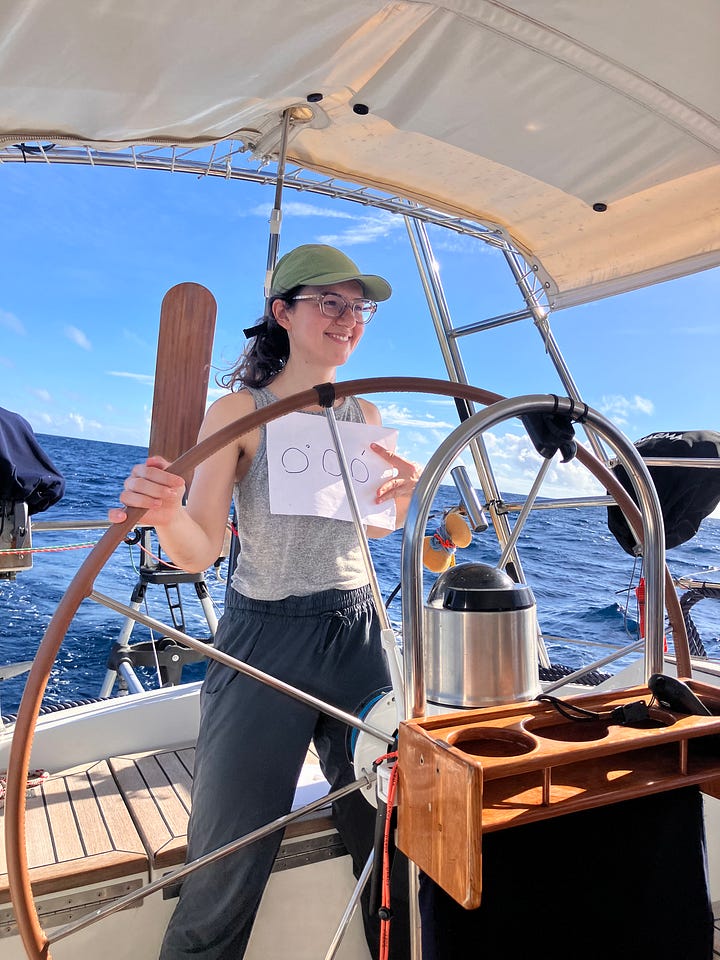
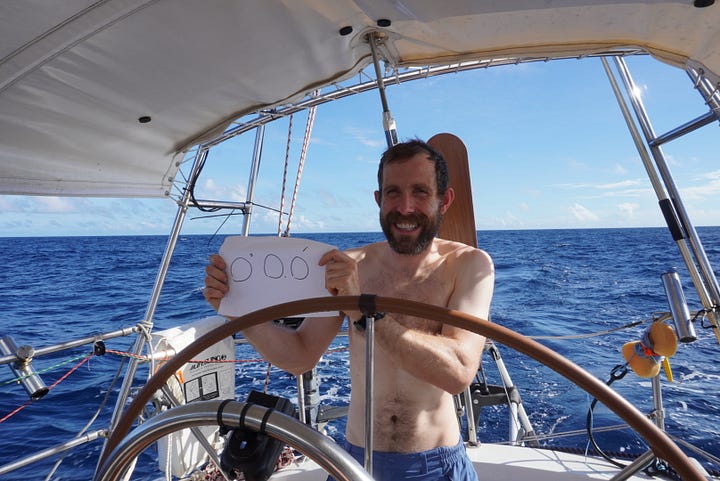
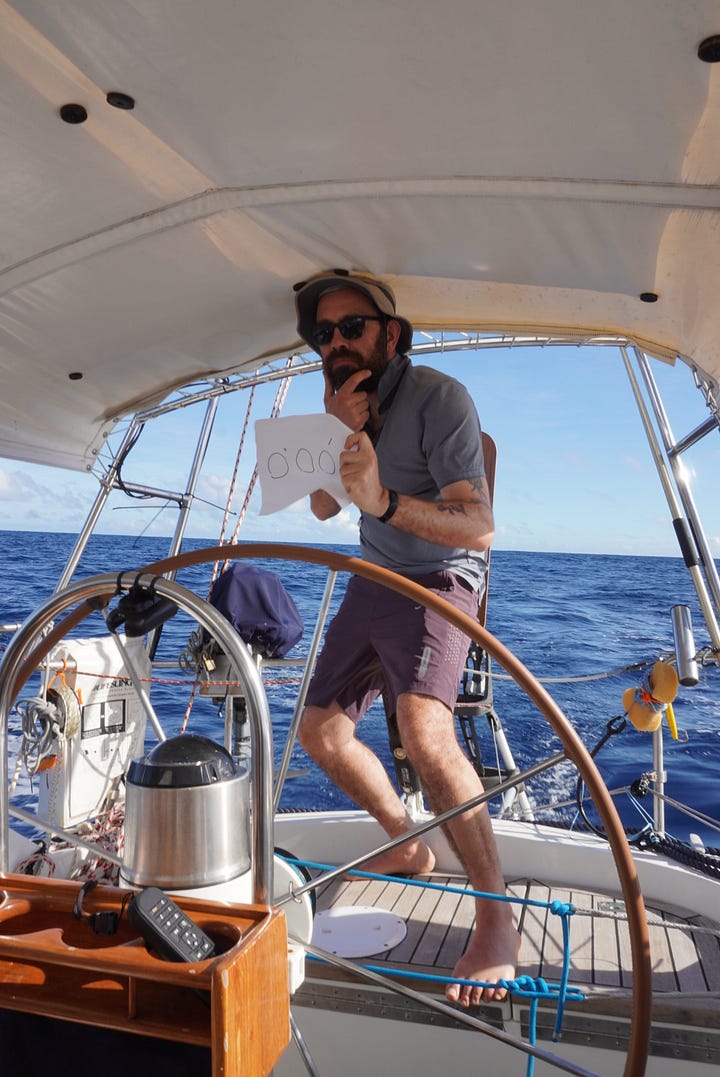

Sewage and heat
Apr 4, 2024
3°39’S 137°50’W as of 2100. Fix on Sirius and Jupiter.
Today was really hot, and the toilet malfunctioned. Sewage is sometimes leaking from the holding tank (really from the hose to the holding tank) back in to the toilet bowl. This is a risk in boat toilets because the holding tank is usually above the toilet. There is a valve to prevent this “back flow”, but ours seems to have partially failed. Not all days can be glamorous. Needing to repair your own toilet (and marine toilets break often) is one of the worst parts of owning a boat. But I’ll fix it! (I have a replacement back flow valve.)
The wind was 12 knots in the afternoon, but we really wanted to swim so we hove to. Boat was still making 1.5 knots, but we jumped in holding a line and got dragged behind the boat. Water was 87 degrees, so it did not cool us off that much.
We’re out of the ITCZ now. Southern trades have set in. The end of leg one is close.
We’re now entering the southwest pacific tropical storm basin on the tail end of their storm season. However, there are no storms of concern right now (and nothing forecast). We expect to be safe at anchor in 3 days.
-Ammon
Land birds and excessive easting
Apr 5, 2024
5°39’S 138°17’W as of 2100
I did a star fix on Regulus, Aldebaran, and Pollux. Stars are in many ways the best bodies for celestial navigation: you can take a bunch of sights at once and get a fix at a precise time (rather than doing a running fix on one body over time), you don’t need to adjust for parallax and relative motion (like the moon and planets) and you don’t need to use dark glass to avoid going blind. Plus, taking sights on stars is just beautiful. However, you do need to be able to see both the stars and the horizon distinctly to get an accurate measurement. This is only possible for about 15 minutes at dawn and dusk. And (during that period) less bright stars are not yet visible, making it hard to identify even the bright stars. The way this is normally handled (what I did today) is to pre calculate about where a star should be (altitude and azimuth), then set the sextant to that location, look through the scope and wait for the star to appear. When it does, take an exact measurement and move on to the next. You start in the east (where the sky darkens first) and then move to the western sky. It’s a beautiful process.
Today, we saw a number of new birds: a beautiful white-tailed tropic bird (with a remarkable, thin tail) as well as a tiny storm petrol with a distinctive white mark on its butt. We also had a bird (we think a brown booby) try repeatedly to land on the rigging. We’re 240 miles from land. It seems that land birds have returned.
When I spoke to experienced sailors about this route, a piece of advice a received multiple times was “Don’t go too far west. Keep a good wind angle in the southern trades.” Well, we’re too far west. To have any hope of making Futu Hiva without tacking, we’re now close-hauled. This means slower progress and less comfort over the next few days. I feel a bit stupid, because even as recently as 2 days ago (before entering the southern trades) we could have avoided this. I did not account for the current associated with the trades. We’re experiencing almost 2 knots of current out of the east. This means that to make 180 degrees true, I need to keep the boat under ~ 165 degrees. That 15 degrees makes the difference between us zooming along at 8 knots, or bashing upwind at 5.
-Ammon
A change of plans
Apr 6, 2024
7°45’S 138°24’W as of 2100, fix on same stars as yesterday. Horizon was hard to make out.
We changed course and are headed to Nuku Hiva rather than Fatu Hiva. This is the largest town in the Marquesas. Yesterday, I noticed that our lower spreaders have deflected upward. Spreaders are an important part of the rig, and if they bend up far enough, the shrouds will not have the angle to support the mast. I *think* that the mast is still adequately supported, but it’s concerning to not know why the spreaders moved. Given this, we’re going to make landfall in Nuku Hiva and have a rigger look at the situation before we explore the remote islands.
So, we’re on a course for Taiohae Bay. We expect to see land tomorrow morning (perhaps as soon as sunrise), and to anchor in the afternoon. We’ll fly a quarantine flag (to show we’re not cleared in to the country) and make radio contact to see how we do clear immigration. I would not be surprised if we’re not off the boat until Monday morning.
It’s funny to have land so close. I feel a little sad that the passage is coming to an end. It’s also disconcerting to know that there‘a something in front of us to run into. After the open ocean, land 60 miles away feels far too close for comfort.
But fresh fruit, a real shower, and cold beverages await. We’re excited.
-Ammon
Safe at anchor
Apr 7, 2024
8°53.9’S 140°6.4’W
We are safe at anchor in Nuku Hiva, Taiohae Bay. The final day put up plenty of last challenges. When we started the engine to make our final approach into the anchorage, no water came out of the exhaust. Water is how marine engines cool themselves, so this was a big problem. I had to go into crazy engine repair mode while Nurcan sailed back and forth in front of Nuku Hiva. I disassembled the cooling water system junction by junction. Water was making it through the engine but not through the lift can (muffler). Draining the muffler solved the problem, and we made it into the anchorage just as the light faded. I need to talk to a mechanic, but I am now highly suspicious that we never had a battery problem and what looked like a failed battery was an engine struggling to start with water infiltration from the exhaust system (flooded by following seas).
We’re exhausted. We did not have time to clean / organize the boat. The deck is strewn with offshore gear / fenders / items we took out of lockers to rig the anchor. The cabin is strewn with engine repair tools.
Tomorrow, we need to clean and organize the boat.
But still, we made it. This is a magical place. I may stop writing daily while we’re at anchor. But I will write more about Nuku Hiva, and I’ll send photos when I have real internet.
-Ammon
An embarrassment of pamplemousse
Apr 17, 2024
We are at anchor in Bay of Virgins, Fatu Hiva. This is a remarkable place. The islands are volcanic, with mountains several thousand feet high in the center and rings of crags and cliffs around the edges—all of this while covered in dense tropical foliage. This is the most remote place I have ever been. The total human population of the Marquesas is 10k (across 7 islands). Mostly, the islands are untouched wilderness. The homesteads or tiny towns that there exist are focused on agriculture (fruit cultivation, fishing). It’s hard enough to get here that tourism has not had much impact. There just aren’t many people.
Today, we hiked to a waterfall. The path was several miles long, beginning in a small town. We walked under 50’ mango trees, over a carpet of fallen fruit. By the end, it was hard to discern the trail up steep rocks, between banyan trees, up and up, to a 200-foot cascade falling into a deep pool in the rock. There were male tropic birds doing a mating dance above us.
The islands are covered in fruit trees(bananas, mango, bread fruit, coconuts), but especially pamplemousse. Pamplemousse is the French word for grape fruit. But these are a distinct variety. They look like pomelo (with think green skin) but have just a touch of the bitterness of a normal grapefruit. We bought a bunch from a man here (he picked them from a tree behind his house in demand). Right now we have a net on the back of the boat full of green bananas and pamplemousse.
The maintenance issues have continued. I was able to fix the engine (with the help of another sailor in the anchorage, who, randomly, was also the person who found George Mallory’s body on Everest). Then the refrigerator stopped working. I was able to fix that too (an obstruction in the cooling water flow). Then we broke the line on our jib furling system and ripped a sail slider out of the mast track. Luckily I was able to fix it all. So far, this trip has so far been defined by camaraderie, incredible natural beauty, and system troubleshooting and self-repair. Lucky I like all these things.
We’re leaving Fatu Hiva early tomorrow in order to get Kai and Nurcan back to Nuku Hiva for their flights. After that, we’ll take on two new crew, explore the northern Marquesas a bit, then sail for the coral atolls of the Tuamotos.
I’ll attempt to restart daily updates here.
-Ammon
Diesel intrigue and hard goodbyes
Apr 20, 2024
Hey everyone! I’m failing at daily update while we’re in port. I wrote the following 2 days ago as we were returning to Nuku Hiva. Kai has left us now. Nurcan flys out tomorrow. I’m sad. In any case, here’s my update from 2 days ago.
9 10S 140 0W
We’re 16 nm out from Nuku Hiva, returning so that Kai and Nurcan can fly back to the US. We left Fatu Hiva 21 hours ago. What was supposed to be a downwind sled ride in the trades turned into an upwind beat in (unforecast) north winds. We did get a few hours under spinnaker in the morning, however.
In most small towns here, there are no restaurant or cafes or taxis or other services. If you want, say, a meal or to buy fruit you just ask someone in the village and they take you to a family willing to host you for a meal or someone with a pamplemousse tree in their backyard. Sometime it’s the same person! A family in Fatu Hiva first picked 10 pamplemousse off a tree for us then made dinner of fried bread fruit and poisson cru (think ceviche with coconut milk).
The heat here is hard to deal with. The thing that makes it OK is that we live on a boat over water and can jump in whenever we want. We swim 5 times per day. At several places this week, there’s also been world-class snorkeling (coral reef, hundreds of fish, dozens of species, sea turtles), all true right off our boat and with no one else around.
The day before yesterday, we had an interesting mechanical mystery with our water system. We have 4 water tanks. There are valves that allow us to fill / use any of the tanks. After these valves, water runs to a non-electric hand pump and filter (and also to a pressurized electric water system). We draw all our drinking water using the hand pump. Well, the day before yesterday, the spigot came off of the hand pump. This did not seem like a big deal. The base of the spigot was threaded. I just screwed it back in place. However, 2 minutes later, Nurcan filled a cup with water, went to take a drink, and spit it out! The drinking water was full of diesel! We’d somehow horribly contaminated our drinking water. What had happened?!
My mind first went to our tanks. We have integral tanks welded into the hull of our boat. This means that a single aluminum plate separates fuel from water. If that plate were to corrode through, the two could mix. This of course would be really bad (we’re hundred of miles away from any facility to deal with the resulting mess, plus we’re relying on both our fuel and our water).
So had the tanks ruptured? It seemed odd to me that this had occurred 2 minutes after the spigot had fallen apart, so I disassembled the spigot. And what did I find? The interior workings of the spigot were full of diesel! We cleaned this out, run a bunch of soap through the lines, purged a few gallons from the tank, and the water is fresh and sweet again.
We’re still unclear on exactly what happened. Is it possible that the hand pump came from the factory lubricated with diesel? This seems unlikely (a remarkably poor design if true). More likely, I think, is that at some point while working on the boat, I spilled diesel around the stem of the pump and it ran into the workings. And that it sat there, waiting, until the pump came apart and it could drain into the water supply.
Back to the present (Friday night) in Nuku Hiva. Nurcan flys out tomorrow. I’ve been planning this trip with her for 18 months. I can’t quite believe that my part with her is over. It’ll be much more lonely from here.
-Ammon

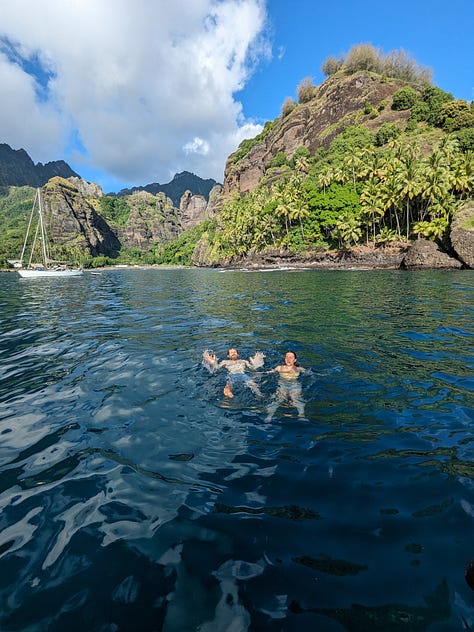
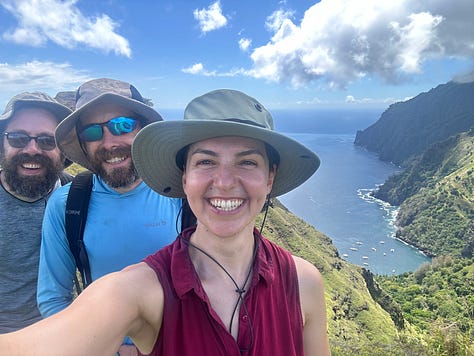

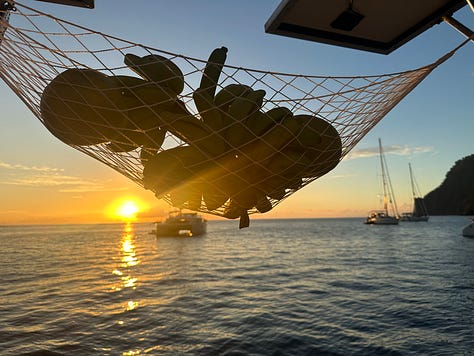
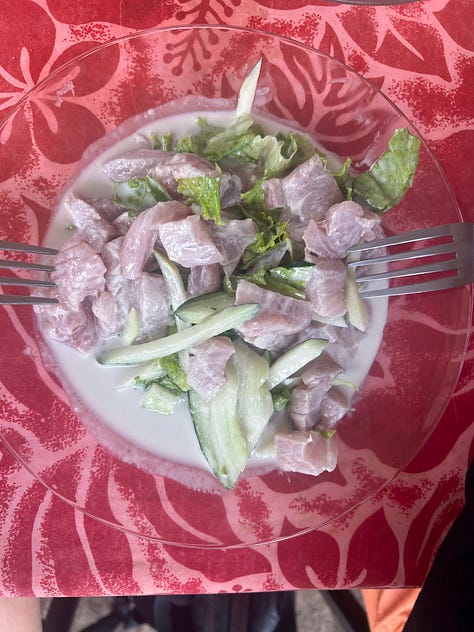
At Ua Pou
Apr 23, 2024
9°23.2’S 140° 7.7’W
We made it to Ua Pou. Beautiful first sailing for the new crew (7.5-knot beam reach in 12 knots of wind). Both Rio and Joseph felt somewhat sick (and a little disheartened, I think). But they went to sleep and seemed to be in good spirits afterward. I hope they develop better sea legs.
The bay here is far less tropical than the other places we’ve been. Rather than lush palms and bananas, there are bare rock walls and grass. I suspect we’re in a rain shadow on the west side of the island.
Rio and Joseph just went off in the dinghy to explore the shore, while I run the water maker to fill the tanks.
Tomorrow, we make for the open sea.
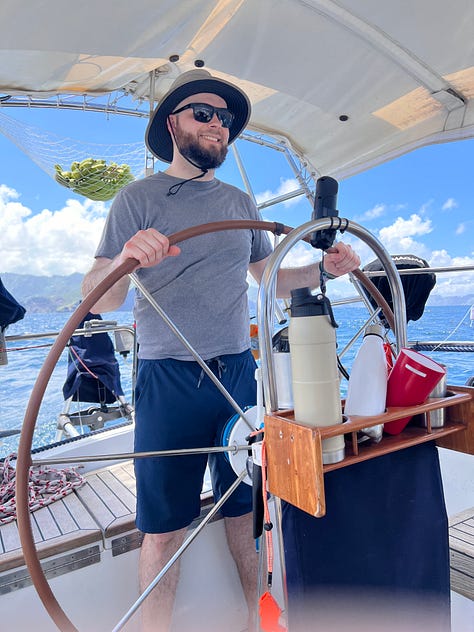
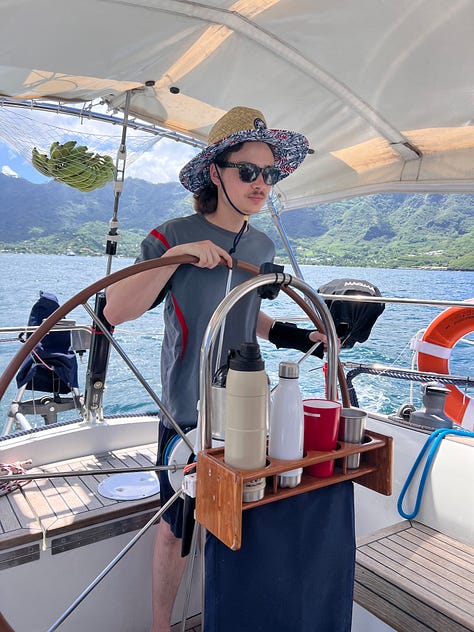
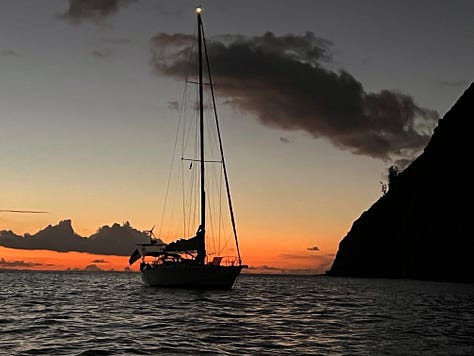
How to hide a lightning rod
Apr 24, 2024
10°28’S 140°33W’
On course for Tahanea atoll. I’m tired because I’ve been up every few hours to help the new crew with their first night watch. Once again, we got quite lucky with the conditions at the start. We have 3-foot seas and 12 knots of wind on our aft quarter. This is already an intense introduction for Joseph and Rio (sailboats underway on the ocean are a more intense experience than most people expect). Imagine if our first night had 10-foot seas upwinds!
I’m standing my night watch now (that’s usually when I write these updates). It’s a mild night, but not a very nice one. The sky is rather light from the near-full moon (no stars) but hazy, mostly cloudy. It’s hot and humid. There’s lightning flashing on the horizon.
I’ve been afraid of lightning as long as I can remember—probably because I grew up hearing about when my father was struck. He was 16-years-old, camping in the backyard at a cousin’s wedding, when the tree he was sleeping under was hit. They rushed him to the hospital unconscious. He almost died and only came to days later with burn marks tracing the blood vessels on his body.
A sailboat’s mast is aluminum and the tallest thing for miles around. We’re a lightning rod with nowhere to hide. Strikes on boats seem to rarely directly injure the crew (the main issue I read about is destruction of the ship’s electrical systems). In our case, the hull is aluminum and (I hope) something of a Faraday cage around us. I plan to send everyone below in a storm. Still, we’ve yet to experience close-by lightning and I don’t want to.
The forecast shows electrical storms in our area over the next two days. The good news is the wind is rising. If our electronics survive, we should blow into the Tuamotus in style.
-Ammon
Fairy lights and forecast bias
Apr 25, 2024
12°37’S 141°48’W
We’re nearly out of the electrical storm warning area, with no trouble so far. Making 6 knots. The wind, however, has been consistently north of the forecast. Right now it’s coming from 40 degrees magnetic (vs 90 degrees forecast). This has actually been true almost our entire time south of the equator. Actual winds have been stronger and at least 15 degrees north of GFS and ECMWF models. I want to start subtracting 15 degrees from the predicted wind angle when planning. Trouble is, if the model showed systemic bias in a region, shouldn’t it itself pick up on that and correct? I guess these are first/principle atmospheric models, not machine learning models, so perhaps not? That’s not good news for our planned leg from Tahiti to Hawaii. With the forecast, prevailing winds it’ll be fine. But with wind 15 degrees to the north, we’ll struggle to make the line.
Last night, around 9 pm, I noticed a faint light on the horizon. There was nothing on AIS or radar and no land in that direction for hundreds of miles. It was eerie. I suppose we’re close enough to Tahiti that it was probably a fishing boat out of radar range. Still, I did not like it. I’m accustomed to being alone out here. And I want to know what I’m seeing.
Our power usage has been rising. I went back over our logs, and we’re using almost 80% more power every night now than we were earlier in the trip. This might be explained by the water being warmer and thus the refrigeration less efficient (refrigeration is our largest load). However, we’re using more now than we did on the equator. I’m going to investigate this more today.
It’s 7:00 am ship’s time. The sun is just beginning to rise. The crew is asleep. I’m planning to surprise everyone with pancakes.
-Ammon
A viking funeral
Apr 26, 2024
13°34’S 142°30’W
Winds today were erratic. We had squalls with 25-knot winds and lashing rain, followed by 5 knots of wind (barely enough to move). This repeated all day. I got a lot of practice putting in and shaking out reefs. It was heavily overcast as well. We generated less solar than on any other day so far on the trip. I’m running the engine now to make up the power reserves.
We use biodegradable paper bowls to save water. That way, after each meal, we just throw them to the sea. Often they float away like tiny boats, and we’ve been making jokes about viking funerals. Well, today, after dinner, we put crumpled paper and olive oil in one of the bowls and set it on fire before throwing the bowl into the water. It was a remarkable sight in the dark. It bobbed on the water a long time, disappearing behind waves and then popping into view again. We last saw the little fire ship over a mile behind us.
I’ve altered course. We were making for Tahanea atoll. However, high waves are forecast for our arrival time. I’ve changed course for Makemo atoll, which has a more protected pass. We expect to arrive early on Sunday.
-Ammon
A big fish and stressful wind
Apr 27, 2024
16°20’S 143°29’W
Right now we’re hove to, 16 miles off Makemo atoll, waiting for morning to attempt to transit the pass. I’m pretty stressed about this. I think the pass itself will not be a problem. However, the wind is now 16 to 20 knots out of the south east, and the village anchorage inside the pass is exposed to the SE. They do have a wharf that supposedly allows med mooring (a mooring technique common in Europe but not in the US that I’ve never done). There’s also a more protected anchorage, but it requires sailing 10 miles inside the lagoon (dodging coral in potentially agitated sea state). There are enough unknowns here that I’m planing to go in the pass and see what it feels like. If none of the options feel comfortable, we can always come back out and heave to again.
Also, we caught a 40 pound skip jack tuna today! We had to plug the freezer back in and fill it with a crazy quantity of fish. I don’t think we’re going to be fishing more anytime soon.
I’ve been awake for most of the last 24 hours. Trying to get some sleep now.
-Ammon
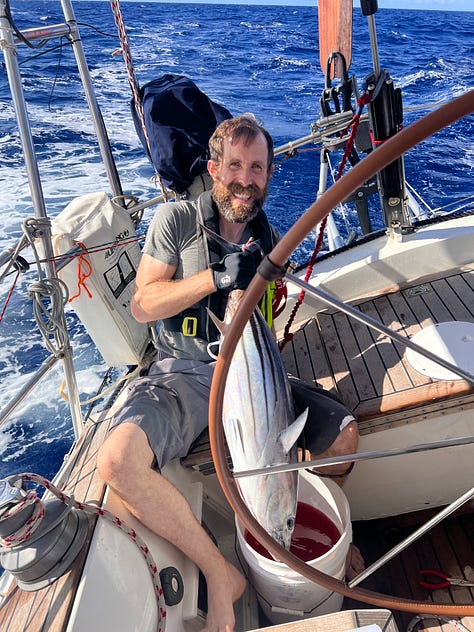
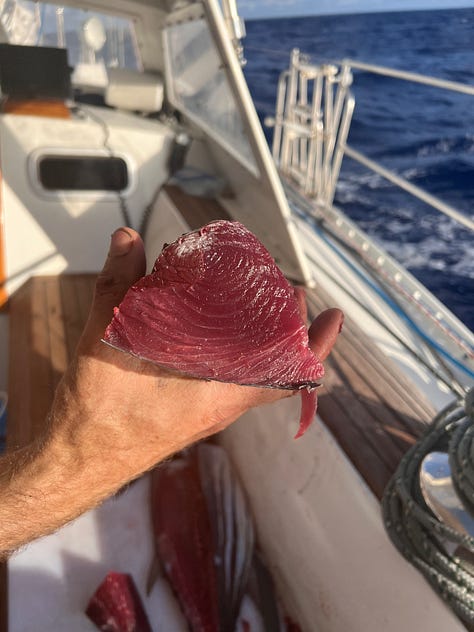
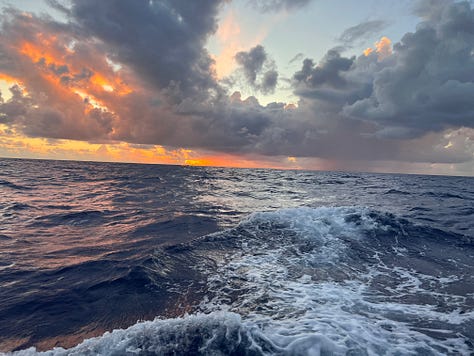
A search for shelter
Apr 28, 2024
16°43’S 144°27’W
What I love most about sailing is the beauty: sea, stars, the arc of the sail against the sky, the heady motion. A close second, however, is the opportunity to be good at a lot of different skills. I feel a drive to know how to tie a zeppelin hitch, to be able to reef downwind in strong winds, to understand how to tune radar to show storms. Mostly, this is positive motivation for me. However, when things go wrong with the boat, I take it personally. It requires confidence to sail this far from support. And sometimes this confidence erodes.
Our plan this morning was to anchor at Makemo. An ocean passage is intense. Even when you enjoy it, it’s natural to focus on the end: landfall. Everyone was looking forward to going for a swim, clean clothing, and a beer.
When we arrived at Makemo, I radioed a boat in the anchorage. They reported that they felt safe on their anchor, but that they were experiencing 20 knots of wind and 4-foot waves. I pained over what to do for 2 hours. We sailed back and forth in front of the pass. But I don’t have experience anchoring in coral or traversing an uncharted lagoon. And it simply was not prudent to make my first attempt at either under 20 knot winds and 4 foot waves.
So, we turned the boat with the plan of sailing to Tahanea atoll and trying the same thing tomorrow.
Then we wrapped the jib.
It was my fault. I did not give clear instructions to the crew on the jib sheets. When you wrap a jib, it gets blown forward and tangled around its stay such that simply pulling the sheet won’t untangle it. You might think a person could just climb up and unwrap it. However, in 20 knots of wind, a loose jib whips back and forth with ferocity and enough force to break bone. The sound is startlingly loud. Any tangle in the sheet is immediately tightened into a Gordian knot. And the whipping back and forth is terrible for the sail. Left for long, the sail will shred.
The solution is to jibe the boat. If you can’t untwist the sail, let the wind hold the sail in one orientation and untwist the boat around it. To do this safely I had to drop the main. We were still less than 1 mile off a coral atoll, so I crash dropped the main. It spilled all over the deck and became tangled.
Everything did work out. Repeated jibing got the jib unwrapped. Then we set the jib and had plenty of time to untangle the main. Still, these were all avoidable mistakes. I did not feel skilled.
And this was not the end of the day’s drama. What had been 20 knots and 4 to 5 foot seas quickly turned in to 27 knots and 8—foot seas. At sea, these are conditions the boat can handle without problem. But we were not at sea. We were in the middle of low coral atolls with channels between them. Navigating this in high wind and waves requires constant attention.
We’re hove to again now, off of Tahanea atoll. The seas space is limited enough that I’ve had to change the tack of the heave to twice to keep us in a 10-mile safe window. All of this still in 8-feet seas. It’s a wild night.
In hindsight, I am certainly glad that we did not go into Makemo. Even if we’d got the anchor down, safe at 20 knots and 4 feet (what the boat I spoke to reported) does not mean safe at 27 knots and 8 feet.
I hope that Tahanea is safe. But I won’t go in if it’s not. We might be out here more days yet, searching for shelter.
-Ammon
Update
Apr 28, 2024 a few hours later
We’re safe at anchor behind a protective reef in Tahanea atoll. Let the wind blow.
-Ammon
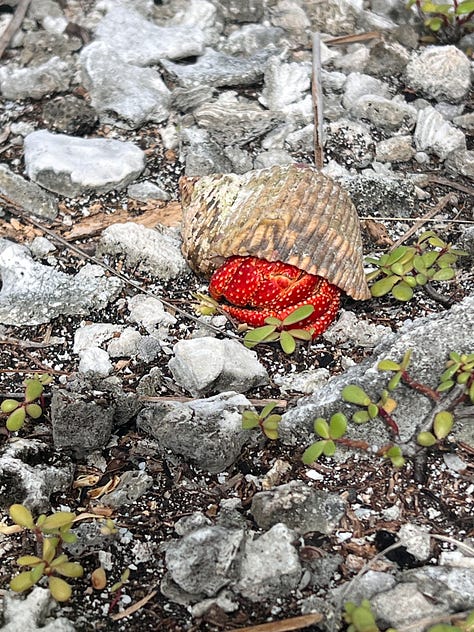

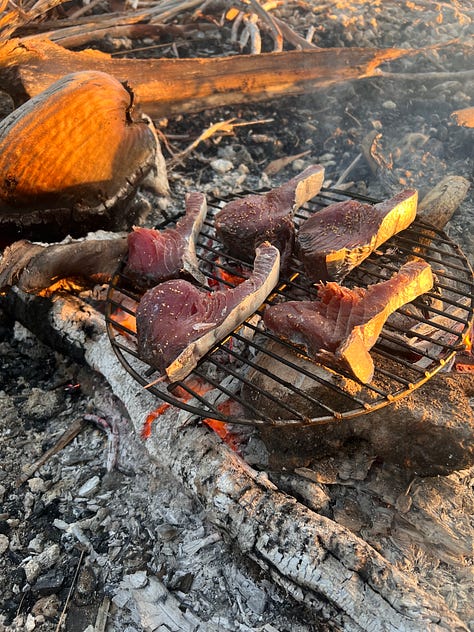
Sharks, hermit crabs, and blue blue water
May 1, 2024
16°50.9’S 144°41.6’W
We’re at anchor just north of the central pass into Tahanea. The water here is an impossible bright turquoise, shifting to white as sand and coral rise to the surface. Everything is coral. Living, branching purple coral in the water. Long-dead, metamorphosed black coral as the structure of the islands. Crushed white coral pretending to be sand on the beach. And there are sharks. It first I was taken aback. There’s just something so scary about the form. But Pacific reef sharks don’t threaten humans. Under our boat, a school of tropical fish have taken refuge. This morning, as I was diving to check our anchor, there was a large predatory fish (in think a wahoo) as well as 4 sharks circling the school.
This evening, we made a fire on the beach. I climbed a coconut tree. We drank water from the coconuts and grilled fresh bread and tuna. It was stunningly beautiful.
One complication: our outboard motor’s transmission broke today (on the way to the beach). It still works in low RPM but disengages at high RPM. I’m going to try to fix it, but I’m not hopeful. On think we may be much more constrained until we get to Tahiti.
-Ammon
Across uncharted waters
May 2, 2024
16°57.4’S 144°35.0’W
My brother Eli and my friend William were both able to diagnose the problem with the outboard. The propeller has a rubber bushing that is designed to shear if the propeller strikes an object. This had failed. I was able to fix the issue temporarily by drilling and tapping holes in the prop hub and adding set screws. We’re in business again! (We’ll pick up a new propeller in Tahiti.)
We sailed across the lagoon today to an area with better protection from the south east winds. Crossing the lagoon is scary because it’s uncharted. Most of the water is 100+ feet deep. But every half mile or so, a coral head comes up (breaking the surface or, even more dangerously, not quite breaking the surface). It’s important that that you sail with the sun behind you, so you can make out the coral heads (we also use satellite images as chart substitutes).
This new anchorage is excellent. At the last place, we had reef right behind us. This is always disconcerting with 20 knot winds. The boat was pulling HARD on the chain, and if the anchor dragged, we’d have had just a minute or two to notice, start the engine, and keep the boat off the reef. In the new anchorage, I have miles of deep water (with just an occasional uncharted coral head) behind me. I’ll sleep well tonight.
We met a family with small kids on another boat here. Stuart gave the kids some books we had (Scuppers the Sailor Dog, and a moonintroll book). The kids were cute and supremely at home on the boat. Nurcan and I are planning to have kids soon. I hope to do something like this with our kids.
-Ammon
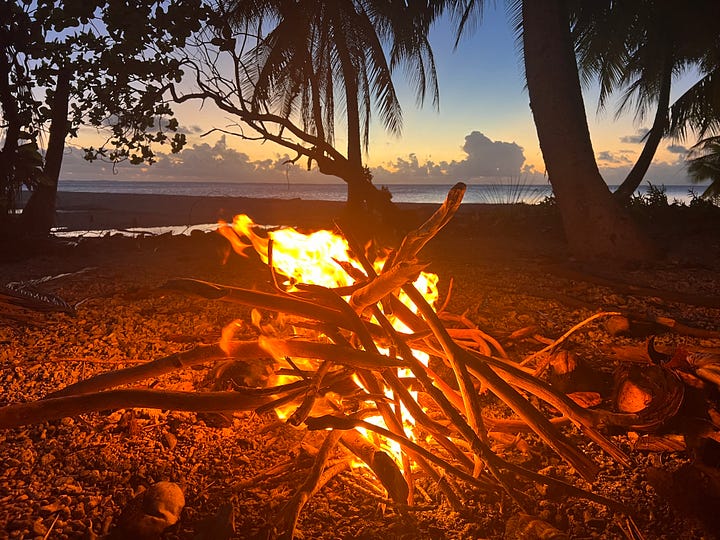
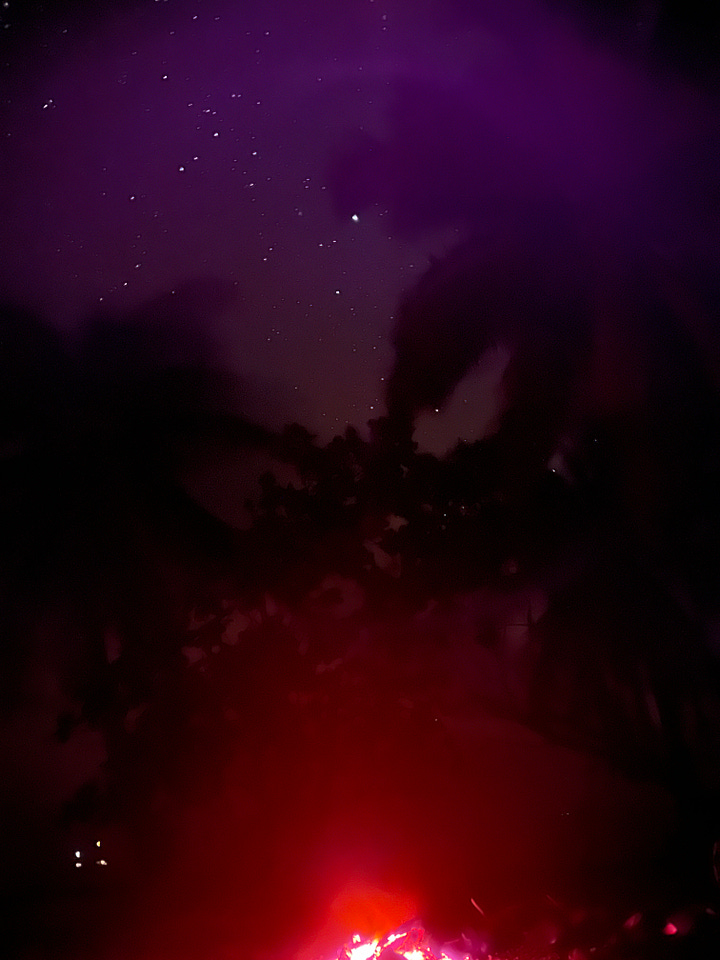
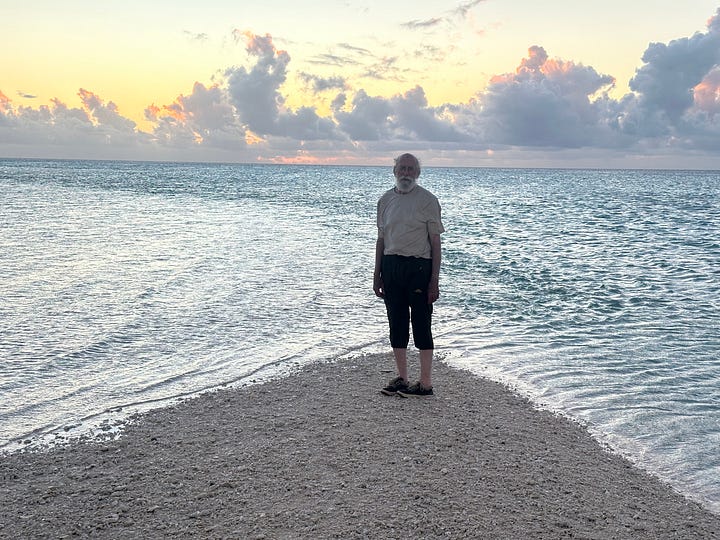
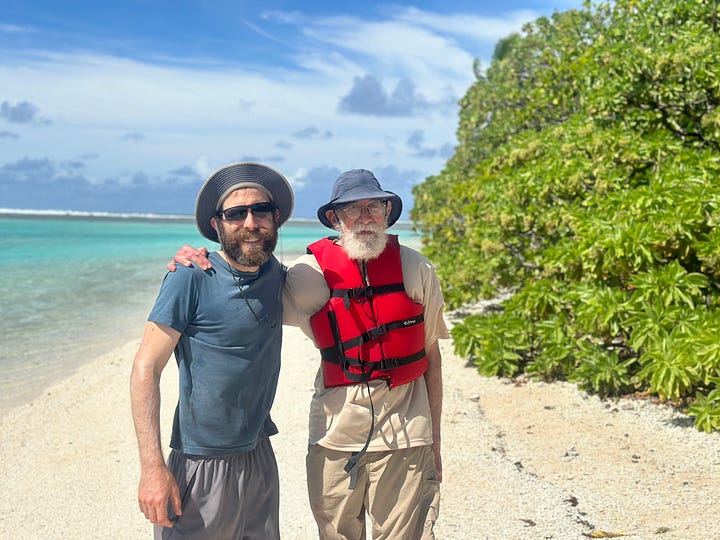
Tahanea to Fakarava
May 3, 2024
16°2’S 145°32’W
It’s 6:00 am, ship’s time (4:00 am local time). We’re just a few miles off the north-east corner of Fakarava. There’s a sliver of moon, but not enough to cast any real light. The water is calm. We reefed the main last night, but I just shook out the reef. Now, we’re under full sail on a beautiful, deep broad reach with 16 knots on our starboard aft quarter. The motion of a sailboat underway has an incredible range. Sometimes, it is hostile, like an animal doing its best to shake you off (or at least spoil the onions you’re trying to dice for chili). Sometimes, it’s calming, restful, rocking you to sleep like night on a train. Right now, the motion is hopeful, forward looking. We bound ahead. Through the wine-dark sea, under every star in the sky, to Fakarava we sail!
The time zones here are shifted early. Under local time, the sun rises at 5:45 am and sets before 6 pm. The people here start their days early! Shops open at 6. In fact, someone somewhere wanted exactly this time badly enough that the chose a non-integral offset to UTC! The marquesas use UTC-9.5. The problem with the early time, on the boat, is that I like eating dinner and cleaning up while it’s light. You’d think I’d be able to just eat dinner at 4:00 pm, then! But I can’t. I’m a slave to what it says on the clock. Dinner is a six o’clock affair. Luckily, I’m also captain. So I just set all the clocks forward. While on passage, we run on ship’s time!
We expect to stay several days in Fakarava. It’s the largest town in the area (population 800!)
-Ammon
Tahiti bound
May 7, 2024
16°14’S 146°52’W
Fix on Spica, Sirius, and Pollux as of 1800 5/7. I’ve not been navigating by sextant while we were around atolls (our exact position mattered too much). It’s fun to be back to it.
Both the autopilot and the self-steering windvane (aka old Daniel) have been performing poorly. The windvane is a known issue. Early in the trip, I bent the fitting where the servo arm connects. Now it can rotate upward by 5 degrees. This decreases the sensitivity of the mechanism (because the arm now wants to trail back in the water). I can fix it temporarily by pushing the arm down and tightening the bolt (this does require basically hanging off the back of the boat to reach). However, I find that I need to re-do this more and more frequently to keep the vane working well.
The issue with the electronic autopilot is new. This afternoon, we were under spinnaker and the autopilot got stuck in 40 degree oscillations. I took the helm and calmed the boat down, but it was a bit of a problem because I needed to get the spinnaker down and no one other than me felt comfortable steering with the boat in that intense a condition.
I’m sure I can at least keep the windvane working (it’s a simple mechanical system). But, man, sailing long distance really is largely about maintaining and repairing boat systems. No one who does not enjoy that kind of thing should do this.
I wrote the following this morning, but did not send it.
======
We just exited the Fakarava pass (channel through the atoll reef), and are on our way to Tahiti to drop off Rio and Joseph and take on my brother Gurney. The pass exit was a little exciting. It’s surprisingly hard to forecast slack current in an atoll pass. The currents are tidal (water flowing in and out as the tide goes up and down). So, at the most basic level, slack current should come at high and low tide. The complication is that the lagoon acts as a buffer. It takes time for all the water to flow in or out of a narrow pass, so the slack current comes some amount of time after the low/high tide. How long after, however, varies by as much as 3 hours based on whether waves are breaking over the reef (all the water that enters has to go out through the pass, so more water entering as breaking waves pushes slack current further out). We’ve had strong wind and large waves here, and low-water slack was apparently shifted forward farther than I calculated. As we exited, we had 4-knots outgoing and 6-foot standing waves. Exciting! Two other boats left right before us, so we were not the only ones to make this mistake. We spoke to one of them on the radio before we went through to make sure it was not too bad.
After we cleared the pass, the sea state calmed down remarkably. Right now we’re in bright sun, making 6.5 knots with no fuss in 15 knots of wind. We’re outpacing the boat that left just in front of us, which makes me feel good! I wonder if they know we’re racing.
-Ammon
An ethnography of cruiser
May 8, 2024
17°18’S 149°25’W
What kind of person takes months or years away from their normal life and crosses thousands of miles of water using 15th-century technology? What is the culture among the people doing this? By way of illustration, here are 5 characters we’ve run into on this trip:
The retired couple
The majority of boats are run by a recently retired couple. They are in their late 50s or early 60s (young enough to still dive their hull or climb the mast if needed). Sailing around the wold is a dream they’ve had for decades, and now they’re finally doing it. There’s something wonderful about these people’s energy (not an energy I’d normally associate with retirees). They previously worked white-collar jobs in LA or Antwerp. (There seem to be more Europeans cruising in Polynesia than there are Americans, perhaps because it’s a French protectorate or perhaps because sailing is just more popular in Europe). The man is almost always the sailing geek (although—good reminder to me—I put my foot in my mouth by assuming this about one couple we met when the woman turned out to be a retired professional skipper).
The adventure parents
This is who Nurcan and I want to be. The beautiful European parents homeschooling their cute kids while taking a 2-year break from dual high-power careers.
The 20-somethings
There are fewer young people cruising here than I expected, perhaps because it’s hard to buy a boat at that age. The 20-somethings there are tend to be in smaller boats. They’re doing this without an electronic autopilot or a fancy desalinator. They just make it work. These are the cruisers I most respect. Sometimes, I feel foolish for not going with a boat like this. (Little My is above the 50th percentile in size and level of equipped-ness among the boats here)
The Danish Teenagers
For some reason, Polynesia is lousy with Danish teenagers on sailing and diving tour trips. They don’t know how to sail themselves (they’re packed into large professionally run sailboats). The only thing I don’t understand is why they’re all Danish.
The Luxury Cruiser
It’s certainly a luxury for anyone to get to sail in the South Pacific. However, the experience of living day-to-day on most cruising boats is far from five star. Rather, most cruisers cram into small spaces, sleep in 90-degree heat without AC, and conserve water. There are, however, super yachts among us. I have less interest in boats with professional crews. For one thing, there’s less common ground. The first question for every other boat is how long was your passage and what broke on your boat? (Something major breaks on every boat.) That commonality is missing for people who did not sail their own boat.
Polynesians culture is friendly. If New York is a 3 on the international friendliness scale (frowns more common from strangers than smiles, passer-by greetings uncommon, motorists liable to display negative emotions) and the American Midwest is a 7 (clerks likely to greet customers with an apparently heartfelt old-timey salutation, motorist likely to make space for a merging vehicle), then French Polynesia is a 9. There is a pervasive lightheartedness. The street dogs don’t bite or shy away, because everyone is decent to them (even when shooing them away). Kids seem to have a larger place in the culture. Where in the US they would be ignored, here, they are placed front and center (a father getting a 2-year old to help pass groceries to a clerk, a street vender with her daughter greeting every costumer).
I did not witness any negative interactions between foreign sailors and Polynesians. Everyone was wonderful to us. Still, there is tension. The boats don’t actually bring a lot of tourist money. Cruisers mostly anchor, swim around their boats, and eat their own food. And compared to the total number of people, cruisers’ boats take up a lot of space. At peak season, they fill the primary anchorages on all the islands. I hear there’s been conflict over privacy (people not wanting the cruisers to anchor right in front of their houses), over trash disposal, and over damage to coral from poor anchor technique. There’s a lot that I like about sailboat cruising. But the very self-reliance that is so appealing makes it a poor medium for cultural exchange and economically not very exciting for local communities. A lot of islands are now banning anchoring (trying to chase the cruisers away).
The islands we have been to were not super developed. Many people work manually harvesting coconuts. The standard of living seems low. I am accustomed to places that feel like that being cheap (at least of you’re spending foreign currency). That is not the case here. The price of a plate of noodles in Fakarava rivals Oslo or Geneva. One small bag of chips in the grocery store costs $8. Part of the explanation for this is that everything has to be imported to this very remote location (the supply ship had broken down when we were in Fakarava, so there simply were no veggies in try stores). But I don’t think that’s the entire story. France pegs the local currency to the Euro. I know that France does the same thing in several ex-French countries in Africa (including Senegal). However, rather than pegging their currency low (as China has done) to advantage exports and tourism, Senegal pegs their currency high. I spoke with one Senegalese person who was quite unhappy with this. He felt it was the local elites increasing their own purchasing power for western luxury goods at the expense of Senegalese industry and agriculture. I wonder if the same critique applies here.
In any case, sorry for the long update. We’re currently hove off of Tahiti, waiting for light to enter. We’ve been dodging fishing boats all night.
-Ammon
A land of milk and honey
May 10, 2024
We’re at anchor in Tahiti. We arrived yesterday. The first thing we did (after completing the legal clearance process at the port) was go to a grocery store. After two months on the boat, the Papeete Carrefour was a cornucopia. Prices be damned, we got sparkling water and 3 kinds of fruit juice and cheesecake
and a watermelon and lettuce and cucumbers and tomatoes (the pattern was cold sweets and crunchy vegetables). It was wonderful. Today, I started the mechanical work. I ordered a new engine battery (we’ll pick it up on Monday). I’m exhausted now! The anchor is set firmly in sand. I’ll sleep well tonight.
-Ammon




